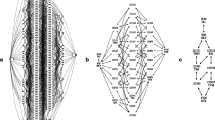Summary
The statistical properties of sample estimation and bootstrap estimation of phylogenetic variability from a sample of nucleotide sequences were studied by considering model trees of three taxa with an outgroup. The cases of constant and varying rates of nucleotide substitution were compared. From sequences obtained by simulation, phylogenetic trees were constructed by using the maximum parsimony (MP) and neighbor joining (NJ) methods. The effectiveness and consistency of the MP method were studied in terms of proportions of informative sites. The results of simulation showed that bootstrap estimation of the confidence level for an inferred phylogeny can be used even under unequal rates of evolution if the rate differences are not large so that the MP method is not misleading. The condition under which the MP method becomes misleading (inconsistent) is more stringent for slowly evolving sequences than for rapidly evolving ones, and it also depends on the length of the internal branch. If the rate differences are large so that the MP method becomes consistently misleading, then bootstrap estimation will reinforce an erroneous conclusion on topology. Similar conclusions apply to the NJ method with uncorrected distances. The NJ method with corrected distances performs poorly when the sequence length is short but can avoid the inconsistency problem if the sequence length is long and if the distances can be estimated accurately.
Similar content being viewed by others
References
Cavender,JA (1978) Taxonomy with confidence. Math Biosci 40:271–280
Effron B (1982) The jackknife, the bootstrap, and other resampling plans. CBMS-NSF Regional Conference Series in Applied Mathematics No. 38. Society for Industrial and Applied Mathematics. Philadelphia, PA
Felsenstein J (1978) Cases in which parsimony or compatibility methods will be positively misleading. Syst Zool 27:401–410
Felsenstein J (1985) Confidence limits on phylogenies: an approach using the bootstrap. Evolution 39:783–791
Felsenstein J (1988) Phylogenies from molecular sequences: inference and reliability. Ann Rev Genet 22:521–565
Fitch WM (1987) On the problem of discovering the most parsimonious tree. Am Nat 111:223–257
Hedges SB (1992) The number of replications needed for accurate estimation of the bootstrap P-value in phylogenetic studies. Mol Biol Evol 9:366–369
Hillis DM, Bull JJ (1992) An empirical test of bootstrapped confidence limits in phylogenetic analysis. Syst Biol, in press
Jin L, Nei M (1990) Limitations of the evolutionary parsimony method of phylogenetic analysis. Mol Biol Evol 7:82–102
Kimura M (1980) A simple method for estimating evolutionary rates of base substitution through comparative studies of nucleotide sequences. J Mol Evol 16:111–120
Li W-H (1986) Evolutionary change of restriction cleavage sites and phylogenetic inference. Genetics 113:187–213
Li W-H, Graur D (1991) Fundamentals of molecular evolution. Sinauer Ass Inc, Sunderland, MA
Li W-H, Gouy M (1991) Statistical methods for testing molecular phylogenies. In Miyamoto MM, Cracraft J (eds) Phylogenetic analysis of DNA sequences. Oxford University Press, New York
Li W-H, Wolfe KH, Sourdis J, Sharp PM (1987) Reconstruction of phylogenetic trees and estimation of divergence times under nonconstant rates of evolution. Cold Spring Harbor Symp Quant Biol 52:847–856
Pamilo P (1990) Statistical tests of phenograms based upon genetic distances. Evolution 44:689–697
Saitou N, Imanishi T (1989) Relative efficiencies of the Fitch-Margoliash, maximum-parsimony, maximum-likelihood, minimum-evolution, and neighbor joining methods of phylogenetic tree construction in obtaining the correct tree. Mol Biol Evol 6:514–525
Saitou N, Nei M (1987) The neighbor joining method: a new method for reconstructing phylogenetic trees. Mol Biol Evol 4:406–425
Sourdis J, Nei M (1988) Relative efficiencies of the maximum parsimony and distance-matrix methods in obtaining the correct phylogenetic tree. Mol Biol Evol 5:298–311
Zharkikh A, Li W-H (1992) Statistical properties of bootstrap estimation of phylogenetic variability from nucleotide sequences: I. Four taxa with a molecular clock. Mol Biol Evol, in press
Author information
Authors and Affiliations
Additional information
Offprint requests to: W.-H. Li
Rights and permissions
About this article
Cite this article
Zharkikh, A., Lit, WH. Statistical properties of bootstrap estimation of phylogenetic variability from nucleotide sequences: II. Four taxa without a molecular clock. J Mol Evol 35, 356–366 (1992). https://doi.org/10.1007/BF00161173
Received:
Accepted:
Issue Date:
DOI: https://doi.org/10.1007/BF00161173




